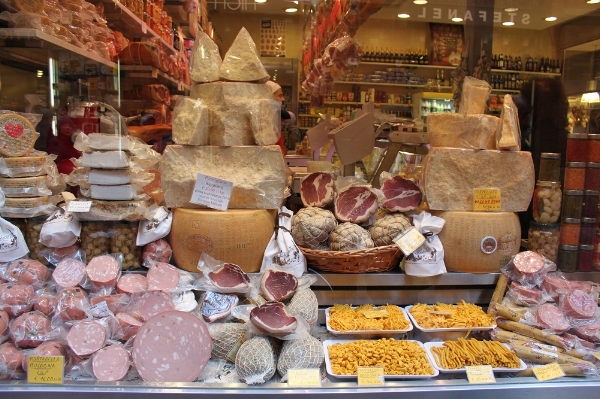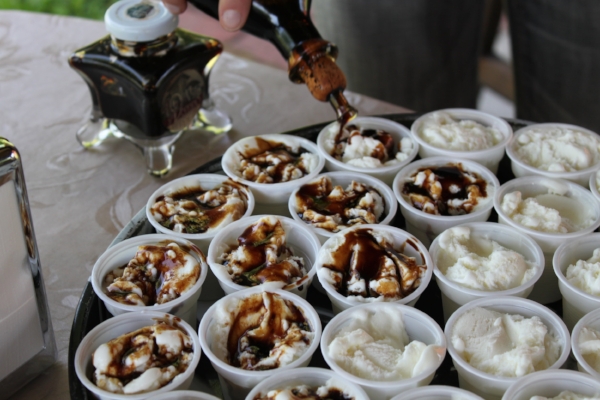There’s no doubt that Italy is the pilgrimage of a lifetime for food-lovers, so it is surprising that comparatively few boot-trotting itineraries include Emilia-Romagna, as compared to your standard Tuscany, Veneto (for Venice) and Lazio (for Rome).
The Emilia-Romagna regions boast some of the tastiest ingredients which define iconic perceptions of Italian food around the world. What would tortellini be without mortadella? Plates of pasta without piles of snowy parmigiano-reggiano? Salads without balsamic vinegar? Charcuterie boards without cured meats?
These delicacies hail famously and are perfected in the Emilia-Romagna, and this region is said to be the most generous agricultural region of the country. It boasts the highest number of DOP consortium-protected products, 42 to be exact!
If you plan on visiting the Emilia-Romagna, make sure to make a stop in la grassa (the fat) capital: Bologna. In this food centric town, you may be overwhelmed by incredible food on every corner, so we’ve put together 9 of our favorite key food & drink in Bologna. You can find 5 essential pasta dishes to eat in Bologna in a previous post.
If you need help in finding where to eat in Bologna and these specialties (plus many others), consider our La Grassa Food Lover's Tour of Bologna
1. Mortadella di Bologna
You won’t find Baloney in Bologna. Mortadella di Bologna is a spiced pork meat, sometimes with pistachios. The pork meat was traditionally ground using a mortar and pestle, hence the name “Mortadella.” It may look like the sandwich meat that you enjoyed at school as a kid, but when you taste it you’ll see why this is one of the stars of our Bologna food tour.
Even outside of Bologna you’ll often find Mortadella included in many aperitivo spreads since it makes the perfect appetizer. Many regions have a distinct variety of Mortadella, but they allow their existence to this classic creation of the city of Bologna.
Baloney is made with pork, chicken, turkey and beef scraps. Mortadella is made from only the finest minced pork sprinkled with cubes of fat taken exclusively from the animal’s neck. Pistachios and black pepper grains are added and the sausage is cooked in brick ovens. Mortadella can trace its lineage back to the Roman Empire and the locals of Bologna have never lost their taste for it. In fact, the city has numerous salumeria dedicated to the cold cut, some of which sell their artisan sausage at upwards of €14 a kilo. When ordering mortadella, never buy it pre-sliced and always eat on the day. It tends to dry out in the fridge.
2. Parmigiano-Reggiano
Next to those nice thin slices of Mortadella on your appetizer plate are no doubt some beautiful chunks of pale golden Parmigiano-Reggiano! Called the “King of Cheeses,” Parmigiano-Reggiano is a hard salty cheese, and while it can be grated onto pasta and risotto a precious wedge of D.O.P. quality Parmigiano-Reggiano makes a great snack.
Made from unpasteurized cow’s milk, production of Parmigiano is long and labor-intensive process. During the aging process each wheel must be cleaned and turned every 7 days, and after a full year they are individually inspected. Only the wheels that pass the test are branded on the rind as D.O.P. Parmigiano is another Italian staple that is widely used, and often misunderstood, outside of Italy.
Parmesan cheese, the most Italian of cheeses, also hails from Emilia Romagna, where they’ve been making it since the 13th century. Like balsamic vinegar, the good stuff is expensive. By law, only cheese produced in this region can be labelled and branded with the coveted ”Parmigiano-Reggiano” seal. If you’re outside of Europe, as a general rule of thumb stay away from anything called Parmesan and go for the full Italian name, “Parmigiano-Reggiano.”
This DOP cheese is available in three types. Giovane (young), which has been aged for a year, vecchio (old), which has been aged another six to 12 months and stravecchio (extra-aged), which has been aged anywhere from three to 12 years. As it ages, Parmigiano-Reggiano takes on notes of mushroom, spices, dried fruit, beef and even tobacco. When buying, only get as much as you need since any leftover cheese will lose flavor the longer it’s kept in the fridge. High quality Parmigiano Reggiano is best served broken into chunks as an antipasto with pears and toasted hazelnuts, dates and walnuts and a drizzle of aged balsamic vinegar.
3. Culatello di Zibello
Another food to try in Bologna is the King of Salumi, Culatello di Zibello. Culatello is made using the muscular inner thigh of the pig and a natural casing, which is wrapped with twine and seasoned with pepper, garlic, and sometimes a dry white wine, all in quantities strictly regulated by the Culatello di Zibello Consortium.
According to the D.O.P. standards, it must be made in the flatlands near the Po river, including the towns of Polesine, Soragna, Zibello, Busseto, San Secondo, Roccabianca, Colorno, andSissa. It is the climate in this area which creates the perfect conditions for aging the Culatello. The winters are long, cold and foggy, and the summers are hot and sunny. This alternation between humid and dry is key to the slow aging of the Culatello di Zibello.
4. Prosciutto di Parma
As its name suggests, Prosciutto di Parma or Parma ham is made in Parma, but did you know Parma is actually Emilia Romagna’s second largest city? Fighting it out with mortadella for the title of the locals’ fave cold cut, this prosciutto is PDO or protected origin and differs slightly from prosciutto found elsewhere in Italy.
Prosciutto di Parma has been titillating taste buds since 100BC, when Cato, the Censor, first mentioned its extraordinary flavor. Its made with specially bred Large White, Landrance and Duroc breed Parma pigs, who enjoy a diet of grains, cereals and whey from nearby Parmigiano-Reggiano cheese farms. The legs of pork are then cured with pure sea salt for at least one year and up to 3 years.
The finished product is sweet and tender and is great on an antipasto platter with melon and figs, as well as wrapped around asparagus and prawns and baked or on top of a pizza just before served.
balsamic on gelato is a real thing and it’s delicious
5. Traditional Balsamic Vinegar
Balsamic Vinegar is another staple of Italian cuisine that you can find all over the world, but what you need to be looking for is Traditional Balsamic Vinegar. Traditional Balsamic Vinegar is only made in Modena and Reggio Emilia, and comes in three protected categories: Aceto Balsamico Tradizionale di Reggio Emilia, Aceto Balsamico Tradizionale di Modena, and Aceto Balsamico di Modena. The thick, rich, glossy syrup is the result of a minimum of 12 years of aging, and is no less prized than a fine aged wine. The multi-barrel process used makes determining the exact age is difficult, so expert tasters from the consortium must judge the vinegars to determine their grade.
Bottles are given color-coded caps to show the approximate age. Various types of wood barrels are used such as oak, cherry, chestnut, and mulberry and the sweet syrup picks up the particular flavors of the wood it was aged in. Traditional Balsamic Vinegar is not for cooking or dressing salads. With notes of fig, molasses and chocolate, it is perfect drizzled over berries or chunks of parmigiano-reggiano!
6. Lambrusco
When Americans think of Lambrusco we think of the (often overly) sweet and frothy dessert wine that our disco-dancing fore bearers drank in the 70s and 80s when it was the the highest selling import wine in the United States. After exploding on the international wine scene, Emilia Romagna’s producers started making Lambrusco a little too enthusiastically. The market was flooded with sickly sweet and shockingly bad bottles of fizz that did the region no favors and soon enough wine connoisseurs were giving Lambrusco a wide berth.
Now that a few decades have past, lambrusco is enjoying something of a comeback as a new generation is ready to discover it’s often underrated subtleties and range. While its reputation arguably suffered quite a bit from the overexposure, Italians excel at preserving tradition regardless of the rise and fall of fads. The Lambrusco grape has been cultivated for winemaking in Emilia Romagna stretching all the way back to the Etruscans, and today is used to produce sparkling red wines that range in sweetness from dry to very sweet.
But the region’s reigning tipple isn’t all fizz and no substance. A bottle of good Lambrusco is a thing of beauty, scented with the aroma of wild cherries and a hint of herbs gathered by the roadside. When made following the Metodo Classico (the traditional method), it’s sleek and elegant with a black red color of the Lambrusco Grasparossa or strawberry tinge of the Lambrusco Sorbara.
There are three types of Lambrusco. Secco or dry is good as an aperitif or with grilled meat mains, semisecco is sweeter and pairs well with pasta dishes, and amabile has a real sweet tooth and is made for cold cuts and cheese. Since Lambrusco does not age well, it is best enjoyed young, making it an affordable choice for laid-back entertaining.
7. Pignoletto
A sparkling, crisp and fruity Bolognese white wine that some people are calling the new Prosecco. Local legend says Pliny the Elder (1st century) gave it the name ‘Pino Lieto’ in his Naturalis Historia, which literally meant ‘not sweet enough to be good and therefore not appreciated by the Ancient Romans, who loved sweet wines. Pignoletto is also the name of the grape used to make the wine, which pairs well with first courses and fish or as an aperitif. Pigoletto is a DOCG wine and is produced in Colli Bolognesi (Bologna hills just west of the city)
8. Crescentine
Almost every region in Italy has its own version of fried dough, each with its own name and slight variation in ingredients and/or shape. In Bologna “crescentine” reign supreme, but move even just to a neighboring city in Emilia-Romagna and you’ll find gnocco fritto, pizza fritta, and torta fritta. There are a few small variations and they can change the finished product quite a bit. Some use water to make the dough while others substitute milk or varying amounts of both, some use a bit of baking soda, while others use yeast.No matter the variation, crescentine should be fluffy on the inside and crispy on the outside, perfect for serving on an aperitivo plate with thinly-sliced salumi and soft fresh cheeses!
9. Pinza
Until now we’ve discussed mostly the savory side of Bologna’s famous culinary delights, but rest assured that no Italian city would dare go unrepresented on the dessert table! Pinza, a dessert traditionally served at Christmas-time, is rolled dough stuffed with“Mostarda alla Bolognese,” a marmalade made with fruits such as pears, apples, and plums, along with almonds, raisins, and yes, a bit of mustard. The surface is glossy with a coating of honey mixed with rum and it is all topped off with bits of sugar. At the end of a long meal during the holidays you’ll find Italians in Bologna dunking their Pinza in red wine. Of course, like basically every Italian sweet, it also doubles as breakfast.
With these 7 comestibles (and 2 quaffable wines) you should have your palate entertained during your stay in Bologna. For all of the above and even more, join us on our La Grassa Bologna Food Lovers’ Tour!














